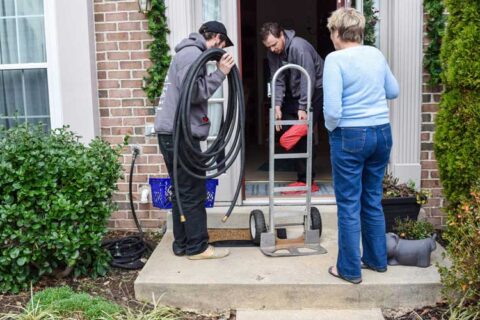Record Low Temps! Should I Adjust Water Heater Settings?

The Baltimore area is experiencing record low temps and the threat of more than a foot of snow. You want hot water. And you want your home safe.
There’s nothing quite like the feeling of being in a hurry to get to work, stepping in your shower, and getting the chilling reminder that there is a water heater somewhere in your house, but it’s not working. There are a lot of things that could be going wrong. And there are a lot of variables to consider to achieve a consistent water temp through the winter months. And adjusting the thermostat may be the simplest solution.
Colder and Older Isn’t Always a Good Combo
Colder water in your home starts with colder water on the ground outside. The water coming into your home needs more heat than usual to get to the temps you’re used to. So guess what? Your water heater has to work harder than usual to get the usual results. More extreme difference in temperatures means more expansion and contraction of the metal parts of the water heater. This leads to leaking water heaters over time. This is one of the many reasons the water heater does not last forever.
A Tiny Tweak May Be All You Need
In the winter months the ground water temp is lower. So it will take longer for the water heater to do its job heating the water to desired temperature. It is possible to raise the temperature on your water heater just a bit to help combat the cold water of the winter months.
But Wait
Adjusting the temp on a gas water heater is easy, it’s just a knob. But an electric water heater means playing around with 240 volts of electricity. Hot water isn’t worth dying for! Call us and let us help.
The best way to check the temperature is to use a thermometer under the flowing water of your faucet — the faucet in your home that is farthest away from the water heater, and the one that’s closest to your water heater and find the best temp in between. Adjust the thermostat until the temp is right and safe for your home.
Other Measures
It may not simply be the cold weather that’s making water temps lower. So instead of adjusting the thermostat, you may want to inspect the appliance to see if there is any buildup of sediment. Flushing your water heater will extend the life of the unit and make heating your water more energy efficient. New water heaters are very well insulated from the factory. An older water heater might enjoy more energy efficiency by adding an insulated jacket.
If you can’t be bothered with any of that because you’re too busy or other things are more pressing, why not call the experts at Speedy Water Heaters? Call today!

